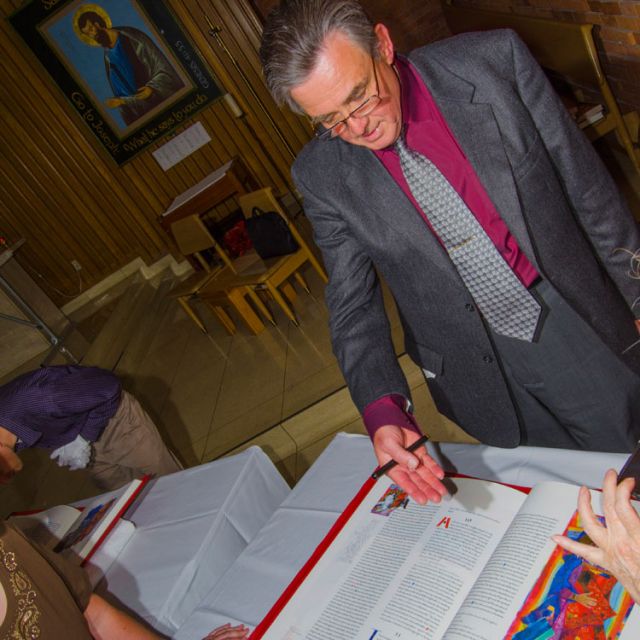“I almost thought that the illuminations meant the pictures itself but I've come to realize the illuminations mean the word of God,” said Fr. Scott Lewis, S.J., director of Regis College's master of theological studies program. “Many people think the word of God means the squiggles on the page, the words that are inscribed with ink on the paper. (But) as we look at the beautiful illuminations of the St. John's Bible we realize that that is theology unfolding.”
Commissioned by Saint John's Abbey and University in Minnesota, the original version of the illuminated St. John's Bible was written and illustrated by the hand of calligrapher Donald Jackson in 1998. Since then about 300 heritage edition reproductions have been made of the 1,150 pages of text and 160 original illuminations. Thanks to George and Gloria Allen from St. Paul, Minnesota, Regis College is the proud owner of one of these editions.
Regis College celebrated receiving the seventh and final volume, Letters and Revelation, of the text on Oct. 9. About 100 people were on hand to hear presentations from experts and take a peak at this powerfully illustrated Bible.
What gives these images such power is there ability to transcend God's voice into modern time, said Lewis.
“We see all kinds of modern images,” he said. “Rather than being some description from 2,000 years ago they could be taken the pages of our newspaper. So those images come very much alive.”
Lewis noted images of oil derricks spilling oil, modern tanks rolling across deserts and magnified depictions of viruses like HIV as just a few examples.
His colleague Fr. Michael Kodarcik, director of masters of arts in ministry and spirituality program at Regis College, also noted that it is God's word which shines through the illuminations.
“What is unique is in the way in which they have organized the illuminations, and certainly the writing of the text, (in that) they are interpretative; they are presenting for us a view of the word of God,” he said.
Kodarcik dug deeper into this concept by explaining that even in the negative images one can still find the word of God, just as one can during the negative moments of life.
“Even in the dark panel you have strips of gold and platinum representing the presence of God,” said Kodarcik. “Even in those places in life where we normally do not expect to find the presence of God, God is there. It is this part of the St. John's illuminated Bible that really gives me inspiration to open the text.”
And while the illustrations provide an ease of access to God's word, the handwritten font of the text forces readers to work, said Kodarcik. But that struggle, he added, is complemented by the easy accessibility of the art.
“It is very hard actually to read the text, it slows you down,” he said. “I was a little worried and apprehensive at the beginning as to what value these heritage editions of an illuminated Bible would have until I encountered the illuminations which are like icons. There is something holy about the illuminations themselves.”
Fr. Gordon Rixon, dean of Regis College, took it one step further by stating that no only do these bring the word of God to us, they also bring us to the word of God.
“If the illustrations present the word of God to us, the art as the illuminations presents us to the word (of God),” said Rixon. “As we encounter the gift of the word expressed in this extraordinary way we weave our thoughts, our fears and our concerns, our joys and our tragedies with the gift of the word. We weave together faith with our living as humans.”
The complete work will be on display at Regis College in a showcase with a page being turned each day.

